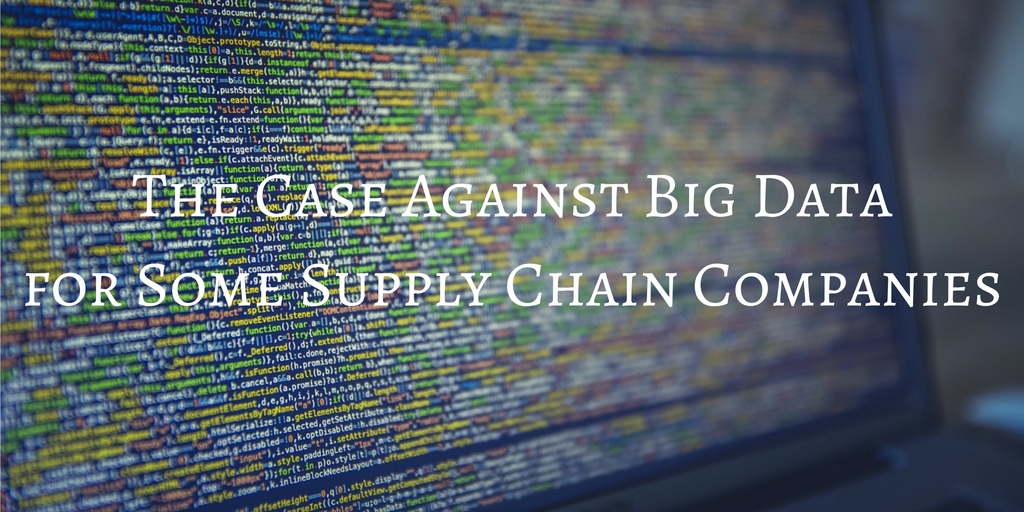
by Jennifer Hart Yim | Dec 6, 2016 | Big Data, Blog, Data/Analytics, Leadership, Logistics, Strategy, Supply Chain, Transportation & Trucking, Warehousing & Materials Handling
Supply chain leaders must be ready to implement big data in order to continuously improve.
This guest post comes to us from Adam Robinson, director of marketing for Cerasis, a top freight logistics company and truckload freight broker.
Supply chain leaders are enthralled with the idea of using big data, but they tend to fail to understand how to disseminate big data in their organization properly. True, they may know how to roll out big data in a single warehouse, or they may have heard their competitors used branded systems for implementing this new technology. However, the fundamental problem remains.
Supply chain leaders must be ready to implement big data and leverage it to improve their companies without any delay or inhibition. This may sound impossible and frightening, but they must only understand how big data always goes back to these two, simple principles of measurement: review and action.
Ask traditional questions, and let big data provide answers.
The most common complaint of newer companies using big data analytics capabilities tends to revolve around traditional questions of business strategy. Consider the following elements explains John Richardson of Inbound Logistics, that impact business strategy.
- Increasing order efficiency.
- Demand forecasts.
- The quantity of each product.
- Inventory location and management.
- Raw material suppliers and logistics.
- Transportation modes used in procurement and shipping.
- Distribution of goods prior to purchase.
- Demand fluctuations.
Each of these elements more traditionally handles by outsourcing analysis of processes to supply chain consultant. This is actually where the concept of third-party logistics providers involved. However, rapid growth and diversification of products are making shippers, manufacturers, and suppliers rethink their business strategy. In other words, consumers can get practically anything they want at a moment’s notice, and more consumers are expressing a willingness to wait for a product a few days if free shipping is a possibility. So, this need to adapt operations reflects the common concerns of traditional customers and supply chain entities. However, there is a distinction.
Previously, these entities only needed to focus on their local demographic for ensuring continued stability. But the rise of the internet has given consumers and everyone else the ability to access any product from any seller and any place on the globe. This is a traditional business strategy, and it is essential that the modern supply chain is willing to use big data all operations to create a more positive result than consumers, stakeholders or government organization ever needed before.
Performance measurement and management.
As explained in a previous blog post, continuous improvement in an organization can be achieved through the use of performance measurement tools via big data. Mostly, this reflects the skills and actual working capacity of employees. Since employees represent one of the largest expenses an organization may face.
Having the best staff members available can mean the difference between success or failure in a company. Furthermore, big data can help employees understand what they do and do not need to do in order to improve their performance scores. This will also help to prevent oversight from managers and keep all employees on track to complete their responsibilities as assigned.
Performance measurement does not have to be limited to the performance of employees either. It can be expanded to identify poorly performing machines, or it can be used to isolate inefficiencies in collaboration with suppliers or vendors. Ultimately, performance measurement is a metaphor for tracking any metric in the course of the supply chain, but it’s key to being effective is found in transferring the insights gleaned from big data into actionable results.
For example the operational efficiency of a given loading is directly related to how quickly pickers are able to fulfill orders and move them onto the dock. Obviously trucks can only be loaded so fast; what is the number of pickers appropriate for the current workload, or which route through the factory is adding an extra 20 minutes to each worker’s duties?
These questions illustrate that the most insignificant details can be driving forces of inefficiency in the supply chain. But they represent opportunities for continuous improvement. Changes in the design or layout of the warehouse or alterations to the truck schedule may require changing the duties of a certain worker at a moment’s notice. Essentially, the worker must be able to access continuous data measurements on all factors affecting his or her responsibilities.
Supply chain leaders need to focus on continuous improvement.
Continuous improvement is a complex notion. It is based on hundreds, if not hundreds of thousands, of individual metrics from various collection points and analyzed in real time. All of this reflects a very large volume of data. It can be digested and broken down into usable bits, much like the biological processes of the stomach making it essential to surviving the coming season.
This comparison is much more than a metaphor; it is the real issue being faced by supply chain entities and their leaders. Supply chain leaders must use big data to gather insight and create quantifiable measures of performance and functionality across their enterprises on a recurring, frequent and immediate basis.
Related posts:

by Fronetics | Oct 26, 2016 | Big Data, Blog, Content Marketing, Data/Analytics, Marketing
Big-data insights can help you segment your email database to better target prospects based on where they are in the buyers’ journey.
Most companies these days are swimming in a sea of big data, the great swaths of information they’ve amassed from sales records, social media connections, website leads and contacts, and online analytics.
At first glance it’s a tangle of information that is hard to organize and even harder to learn anything from. That’s a stumbling block that forward-looking businesses need to overcome. Big data can help breathe new life into one of the most reliable yet shopworn tools of the trade: email campaigns.
Embrace Big Data
A study by the executive head-hunting firm Spencer Stuart surveyed 171 companies regarding big-data usage. Just a little over half of the companies used their big data to help guide email, SEO, and SMS marketing campaigns. That’s a fairly low rate, given the potential leg-up that big data can provide.
Consider what Walmart is doing. The company has big-data information on about 60% of all Americans, with which it micro-targets customers based on their individual interests and habits. It’s a powerful strategy that is spreading quickly to businesses of all sizes.
How can you use big data to freshen up your email campaigns?
Be a Collector, Not a Hoarder
Chances are, you are obtaining a lot of data, especially if you have an active content marketing plan in place. Not all of the data you get is equally important. Your focus should be on data that can lead to an actionable and quick response — for example, are you gathering information on your customers’ buying habits? Do you know who they are, where they are, what their interests are, what their email address is, and how your business connects with them?
Collect that relevant data and study it. Much of it will come from the buyer’s journey — the breadcrumbs that potential buyers leave for you in your big data. These pieces of information are keys to your personalized email responses.
Respond In Kind
Most experts agree that a quick and targeted email response is a good strategy for encouraging a new customer to make a purchase. The email needs to respond directly to the buyer’s interests — using information you’ve (hopefully) logged with your big data.
From this point on, it’s crucial to make sure that every email that is sent to that buyer is built around a backbone of big data. Nurture your customers with personalized emails that offer content and deals that line up with their specific interests.
Don’t Mess with the Masses
Mass emails — the generic sales pitch email — used to be the cost-effective and simple way of reaching and converting customers. Now, it’s more than likely they’ll get sent to the trash, or worse, the spam filter. The mass email is your one-way ticket to spam purgatory.
“Traditional methods of mass marketing doesn’t resonate anymore and they’re being ignored by the audience,” said Volker Hildebrand, Global Vice President of Strategy at SAP Hybris, in a recent interview with Forbes. “Data is the fuel for customer engagement, and being able to pull together all the relevant information about in real-time.”
You can do better than the mass email approach. If you’ve collected relevant data and you’ve studied your buyers’ journeys, you have the tools in place to build a smart email campaign. Tailor your campaign to personalize your approach to your customers, and more than likely they’ll open that email.
Related posts:

by Fronetics | Oct 20, 2016 | Big Data, Blog, Data/Analytics, Logistics, Manufacturing & Distribution, Strategy, Supply Chain, Warehousing & Materials Handling
These industry leaders are leveraging insights from big data to solve business problems and drive profitable customer action.
Big data is more than just a buzzword: It’s helping companies make big-impact business decisions based on customer behaviors, purchasing patterns, and preferences.
Not all organizations have the resources to invest in big data. But for those that do, the payoff can big significant. The trick, of course, is knowing which numbers to analyze, what can be predicted, how to use big data for your particular business needs.
Let’s look at five big brands that are leveraging big data successfully to drive profitable customer action.
How 5 big brands use big data
1. Amazon
Amazon’s free same-day delivery service, Prime Now, allows Prime members to shop for over 25,000 products that can be delivered to their doorsteps within two hours. How can Amazon accurately predict the specific wants of millions of people across the country at a given time to prepare local inventory for immediate delivery? Aside from efficient warehousing and logistics, the company uses data on purchase history to optimally locate and stock its warehouses. This strategy also helps to reduce the time inventory stays in stock, diminishing working capital requirement.
2. Starbucks
Have you ever wondered how two neighborhood Starbucks locations can both stay in business? The company examines data on local traffic, demographics, and customers to determine the potential success of a new location before expanding. Starbucks can then choose to open a new store where it would be most successful, even if it’s just a few blocks from one of their other locations.
3. Walmart
In preparation for Hurricane Sandy, Walmart analyzed historical sales data before expected inclement weather and found an uptick in sales of flashlights, emergency equipment, and — to everyone’s surprise — strawberry Pop-Tarts in several locations. The company has since leveraged timely analysis of real-time data to drive business performance. As Walmart Senior Statistical Analyst Naveen Peddamail told Forbes: “If you can’t get insights until you’ve analysed your sales for a week or a month, then you’ve lost sales within that time. Our goal is always to get information to our business partners as fast as we can, so they can take action and cut down the turnaround time. It is proactive and reactive analytics.”
4. Rolls-Royce
Rolls-Royce has implemented big data processes in three key areas of their operations: design, manufacture, and after-sales support. Each design simulation for one of their jet engines, for example, generates tens of terabytes of data, which computer systems analyze to determine the viability of the design. The company’s manufacturing systems are increasingly moving toward a networked, Internet of Things (IoT) industrial environment. And after-sales support is completely changed by big-data analysis. Expert engineers continually examine real-time analysis from sensors fitted to all Rolls-Royce engines and propulsion systems to diagnose faults and mitigate issues.
5. Capital One
Big data helps Capital One determine the optimal times to send particular customers certain offers. The team analyzes demographic data and spending habits of their customers to optimize their offerings, which has increased conversion rates on their offers and generated more leads from their marketing budget.
How does your business use big data?
Related posts:

by Fronetics | Sep 7, 2016 | Big Data, Blog, Data/Analytics, Logistics, Strategy, Supply Chain
While the temptation to invest in big data may be strong, small and mid-sized companies might be better off starting with small, more manageable analytics.
Big data has become a big business. A 2016 Forrester report forecasts that the big-data management business will grow by 12.8% by 2021. It’s easy to see why, with the prevalence of stories from brands like Wamart and Rolls Royce that have perfected the science of capitalizing on detailed insights about customer behavior.
But many organizations — particularly small to mid-sized companies — are learning that big data does not always equate to big payoffs. In fact, many organizations have sunk millions of dollars into sophisticated data-analytics software only to realize they don’t have the capabilities to interpret the new insights nor the expertise to turn them into a competitive advantage.
Big data and the supply chain
Companies within the logistics and supply chain industries aren’t immune to this trend. An Accenture survey of more than 1,000 supply chain executives found that 84% have already employed big-data analytics or are in the latter stages of planning to do so. Respondents reported:
- 17% have implemented analytics in one or more supply chain functions.
- Three out of 10 have an active initiative to implement analytics in 6-12 months.
- More than one-third (37%) were engaged in serious conversations about implementation.
The promising applications of big data and how it might “revolutionize” the supply chain are hard to ignore. Increased efficiency across the supply chain, improved forecasting, better cost control, more accurate inventory planning: the list of benefits go on and on. These could lead to a significant advantage for companies with the expertise, structure, and knowledge to collect, analyze, and draw strategy cues from large sets of raw data.
But, again, small and mid-sized companies usually aren’t well positioned to do so, unfortunately.
Instead, start small
Supply chain and logistics organizations that don’t have such capabilities — or the capital to invest in technology that can do it for them — should start small instead. Even if you eventually want to implement a big-data strategy, there is a long-term benefit to gleaning insight from small data sets in the interim.
Here are some steps for getting started:
1) Determine your goals
Consider your business objectives and how you can leverage data to further your goals. Focus on just one or two areas for improvement, and clearly articulate what kinds of data you want to collect as they relate to those objectives.
2) Identify your sources
From where will you collect your data? Analyzing numerous data sets from a variety of sources will leave your head spinning and you none the wiser. Also determine which metrics will be most helpful to you, and which you can set aside.
3) Pick your people
If your company doesn’t have in-house analytics expertise, work to attract the appropriate talent. Regardless, integration and structuring of analytic personnel positions will be a more significant factor in your success than your use of even the most advanced statistical software program.
4) Master reporting
Finally, spend some time determining how your findings should be presented. You’ll want them to be formatted in a clear, digestible manner with a clear application for how they will improve your business.
Related posts:

by Elizabeth Hines | Aug 25, 2016 | Blog, Data/Analytics, Leadership, Strategy
Forget tracking traditional metrics and focus on decision-quality data that helps front-line managers do their jobs.
It’s safe to say that the clients I engage with fall into two categories when it comes to business data: those that are drowning in it, and those that ignore it altogether.
The ones that are drowning in data know all the relevant facts that keep them out of trouble with their boards or their senior executives, but struggle to tell you what really drives their business costs or profits. The ones that ignore the data are the savvy veterans that rely on their historical win/loss records in their business, but ask them to change course or innovate, and they are like fish out of water.
Chances are you’ll fall somewhere close to those two camps, and for some time, I did as well. Then that I realized that tracking data for the sake of “tracking” was a waste of time for me and for my teams.
There is data, however, that should be tracked relentlessly and used in all of your decision processes. I call this “decision-quality” data. These are the numbers that drive your business strategy and execution.
What is decision-quality data?
Decision-quality data goes beyond the traditional profit/loss packages that are churned out every quarter and disseminated to your business chieftains. Decision-quality data sets are the building blocks and the levers of your business. Examples include areas of your business that can be affected by the execution of your employees.
Put simply, your sales employees may not be able to directly affect your finance treasury function, but working together with your finance team, they can affect cash flow by selling credit-worthy customers, cutting better financial deals, and, when necessary, helping in the collection process.
The same can be said of your purchasing professionals teaming with distribution leaders and finance team. This team can coordinate at the front line to cut costs and reduce inventory spend by developing inventory and financial metrics that matter to them and the company overall. By working in concert, they have the ability to solve the problems that arise and avoid pitfalls in real time instead of reacting when the quarterly metrics come out.
Quite frankly, if you are collecting and looking at data, but not taking action as the result of it, STOP. You won’t miss a thing, and your team will thank you for saving them time to spend on more productive activities.
Don’t fall into the data-cycle-trap dictated by data tracked on a calendar basis for the sake of tracking. Ask your teams what data they need to be effective, and simplify the way for them to get it in near real time.
Once this type of data is in the hands of a cross-functional team of front-line managers, task them with the needed improvement, and watch them make dramatic impacts in your overall business performance and customer experience and, in turn, your profits. The results will be better and more sustained than if you drove them with a mandate from the top because these managers live and breathe in the environment that created the data in the first place. Their cross-functional nature and familiarity with the issues are a winning combination.
Related posts:

by Elizabeth Hines | Aug 16, 2016 | Blog, Data/Analytics, Logistics, Strategy, Supply Chain

Look at your financial metrics on a granular level, beyond the basic snapshot, to identify opportunities for growth.
Big data can show homogeneous revenue opportunities and cost inputs. But that overview is inadequate for determining how different aspects of your business are performing and where opportunity for growth may lie.
Essentially, you need to analyze your financial metrics at a granular level rather than in aggregate. For example, your business probably offers several products or services and feeds off of more than one revenue stream. Each must be evaluated separately in terms of value and profitability to determine how each is performing, rather than just examining your entire portfolio as a whole.
The key to increasing profits is not always blazingly obvious, but rather it is hidden in the minutia. There you will identify what is growing the business and what is not.
How to get down to the granular level of your financial metrics:
Consider your sales figures.
What is your profit — broken down by product, brand, region, etc.? Note any similarities and differences. Can you identify outliers? Can you identify what works and what your barriers are? If not, you must drill down further. For example, if a specific product is successful, why is this so? Is its success the result of a team or an individual? Can this knowledge or skill be applied to other products or services?
Identify products, brands, or services that don’t make financial sense.
You know they exist already. They are the ones that eat up your resources or simply no longer fit well with your brand. It may be time to eliminate ill-fitting clients, products, or services that don’t benefit the company. You then can pour the freed-up resources into higher-profit activities.
Know what the critical numbers are.
What is important to your business can be very specific to your industry. Inc. magazine’s guide to tracking critical numbers offers a great example: “A software consultant may focus on billable time, for instance, while a food retailer should be looking at sales per labor hour.”
Repeat this review process often.
This is not a one-time exercise. Typically, financials should be reviewed monthly, but each business will vary. Things that ebb and flow, like inventory or manufacturing output, should be reviewed each day, and the sales pipeline should be examined once per week.
Related posts:






